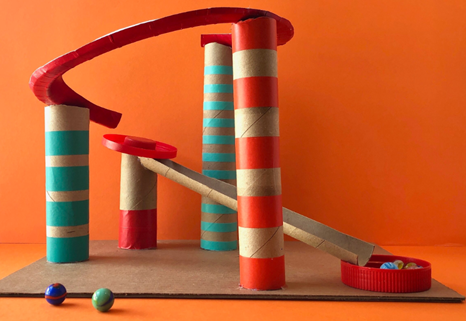Step-by-Step Guide: How to Make a Marble Run at Home
- 211
- 98
Step-by-Step Guide: How to Make a Marble Run at Home
- By huawei-accessories.com
- 11/02/2025
Creating a marble run at home is a fun and educational project that provides hours of entertainment and learning opportunities. Whether you’re building it with your children or as a hobby on your own, constructing a marble run stimulates creativity, problem-solving, and fine motor skills. If you’ve ever wondered how to make a marble run, this guide will walk you through each step of making your own marble run from start to finish using materials you probably already have around the house. By following our easy instructions, you will have a marble run designed to capture the imagination and curiosity of users of all ages.

What Materials Do You Need for a DIY Marble Run?
To create a marble run at home, you don’t need specialized or expensive materials. Here’s a comprehensive list of items that you can use:
1. Marbles – The star of the show! You can use any small spherical objects, but marbles work best due to their smooth rolling ability.
2. Cardboard – Recycle any cardboard boxes you have lying around. Use these for the base and the structure.
3. Paper Tubes – Toilet paper rolls, paper towel tubes, and other cylindrical paper products are great for making tunnels and tracks.
4. Tape and Glue – Use strong adhesive materials like duct tape, masking tape, or a hot glue gun to secure parts together.
5. Scissors/Craft Knife – Essential for cutting the cardboard and paper tubes to the necessary sizes and shapes.
6. Markers/Paint – Optional but fun for decorating your marble run and making it more visually appealing.
7. Various Household Items – Items like plastic spoons, cups, straws, and popsicle sticks can be used to create additional pathways or obstacles.
8. Base Board – A large piece of wood or a sturdy cardboard sheet to serve as the foundation of your marble run.
Having these materials on hand will make your building process smoother and allow for greater creativity and customization in your marble run design.
How to Plan Your Marble Run Design
Understanding Basic Principles of Marble Runs
Before starting, it’s important to understand the basic principles that govern marble runs. Gravity is the main force that moves the marbles from the starting point to the end. Therefore, ensuring there is a downward slope in your tracks is crucial. Additionally, friction and obstacles can slow down or alter the path of the marble, which should be accounted for when designing your layout.
Sketching Your Marble Run Layout
Begin by drawing a rough sketch of your marble run on paper. This doesn’t have to be highly detailed but should outline the placement of key elements like the starting point, tracks, turns, and end point. Mark any obstacles or special features you want to include.
Step-by-Step Instructions to Build Your Marble Run
Preparing the Base Structure
Start by preparing your base board. Lay it out flat and ensure it’s sturdy enough to support your marble run. Next, sketch the outline of your main tracks directly onto the board. This gives you a visual guide as you build.
Constructing the Tracks and Pathways
Cut your paper tubes or cardboard into track sections. These will be your pathways for the marbles. Secure them to the base board using tape or glue, aligning them with the sketches you’ve drawn. Ensure each section has a slight downward slope so the marble can roll smoothly.
Adding Features and Obstacles for Extra Fun
Incorporate various obstacles and features like tunnels made from paper tubes, zig-zag paths using straws, and spirals. Use plastic spoons or spoons cut in half as track diverters and add ramps made from folded cardboard.
Ensuring Stability and Safety
As you start attaching pieces, regularly test the stability of your marble run. Ensure no sharp edges are exposed and that all pieces are securely fastened to prevent collapse. Run a marble through the course to check for any points where the marble may get stuck.

Testing and Troubleshooting Your Marble Run
Once your structure is complete, test your marble run thoroughly. Drop a marble at the start and observe its journey to the end. If the marble gets stuck or doesn’t move smoothly, troubleshoot by adjusting the angles of the tracks or adding more support. Fine-tune any areas where the marble’s movement slows down or stops completely.
Conclusion
Building a marble run at home is an enjoyable and rewarding project that enhances creativity and problem-solving skills. By following this guide on how to make a marble run, you can construct a marble run using easily accessible materials and enjoy the process of crafting and refining your design. Happy building!
FAQ
Can I make a marble run without specialized materials?
Absolutely! Your marble run can be constructed using common household items such as cardboard boxes, paper tubes, plastic spoons, and tape. Creativity in repurposing materials is key.
How can I make my marble run more challenging?
Introduce more obstacles, tighter curves, steeper drops, and multiple pathways. Making adjustable tracks can also add to the complexity as you tweak and refine the pathways.
What are some common mistakes to avoid when building a marble run?
Ensure your tracks have a continuous downward slope, avoid using flimsy materials that can bend easily, and secure all parts firmly. Regular testing throughout the construction can help avoid common pitfalls.





![[VLOG interlocking report] Try the combination of Manfrotto's Nitro Tech 608 and iFootage's TC6 [VLOG interlocking report] Try the combination of Manfrotto's Nitro Tech 608 and iFootage's TC6](https://website-google-hk.oss-cn-hongkong.aliyuncs.com/drawing/article_results_9/2022/3/25/278166fcc7181b73dd99af1b87fd6482_0.jpeg)









